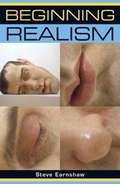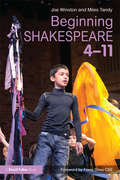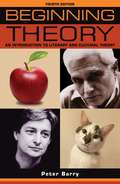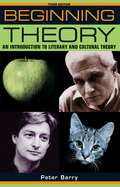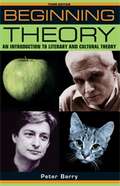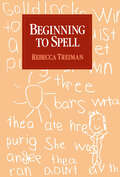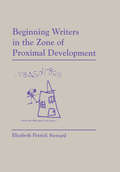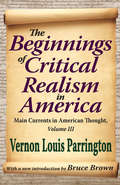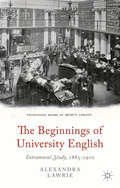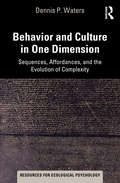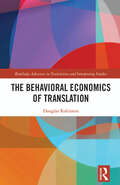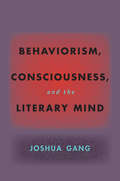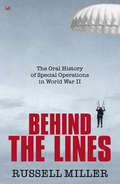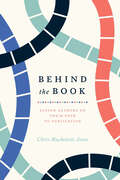- Table View
- List View
Beginning Realism (Beginnings)
by Steven EarnshawRealism is an essential concept in literary studies, yet for a variety of reasons it has not received the attention and clarity it deserves, often being dismissed as ‘too slippery’ to be of use. This accessible study remedies that failing for students and scholars of English Literature and Literary Theory alike, plainly setting out what realism is, the issues surrounding it, and its role in other major literary modes such as modernism and postmodernism. Beginning Realism gives detailed coverage of the nineteenth-century realist novel through its focus on novels by Gaskell, Eliot, Trollope, Dickens, Mrs Oliphant, Thackeray and Zola. As well as discussing ‘the novel’, the book also includes chapters on the use of realism in drama and poetry and a chapter on ‘the language of realism’, another aspect often overlooked in analysis of the concept.
Beginning Shakespeare 4-11
by Joe Winston Miles Tandy'This book is clear, approachable, and true. The elegant simplicity of its good guidance is the product of years of practical experience in the classroom. I wholeheartedly commend it to primary school teachers everywhere.' Michael Boyd, Artistic Director of the Royal Shakespeare Company Shakespeare’s plays are widely regarded as the greatest inheritance in English literature and recent years have seen a growing interest in introducing them to children in their primary schools. In this book, the authors bring a blend of clear thinking, playful and inventive practice and straightforward practical advice to bear on teaching Shakespeare in the primary school. Children who encounter Shakespeare early have the opportunity to become comfortable with the plays, their stories, characters and settings, long before they might become intimidated by their associations with exclusivity and ‘high’ culture. They are also given the chance to become familiar with and absorb his powerful and complex language at a stage when they are constantly encountering new vocabulary. To do this most effectively demands a dynamic pedagogy, one which recognises that the plays are best explored and understood through active, physical engagement. Beginning Shakespeare 4-11 offers a sound rationale for teaching Shakespeare in primary schools and shows how to engage children with Shakespeare through story, through the very best of early years practice, and through his rich and sensual language. It also illustrates how engagement with the plays and their language can have a dramatic impact on children’s writing. And because plays are for performing, there is helpful and practical advice on how to develop the work and share it with the whole school, parents and the wider community. This accessible and comprehensive guide is ideal for teacher trainees and practising primary teachers everywhere.
Beginning Shakespeare 4-11
by Joe Winston Miles Tandy'This book is clear, approachable, and true. The elegant simplicity of its good guidance is the product of years of practical experience in the classroom. I wholeheartedly commend it to primary school teachers everywhere.' Michael Boyd, Artistic Director of the Royal Shakespeare Company Shakespeare’s plays are widely regarded as the greatest inheritance in English literature and recent years have seen a growing interest in introducing them to children in their primary schools. In this book, the authors bring a blend of clear thinking, playful and inventive practice and straightforward practical advice to bear on teaching Shakespeare in the primary school. Children who encounter Shakespeare early have the opportunity to become comfortable with the plays, their stories, characters and settings, long before they might become intimidated by their associations with exclusivity and ‘high’ culture. They are also given the chance to become familiar with and absorb his powerful and complex language at a stage when they are constantly encountering new vocabulary. To do this most effectively demands a dynamic pedagogy, one which recognises that the plays are best explored and understood through active, physical engagement. Beginning Shakespeare 4-11 offers a sound rationale for teaching Shakespeare in primary schools and shows how to engage children with Shakespeare through story, through the very best of early years practice, and through his rich and sensual language. It also illustrates how engagement with the plays and their language can have a dramatic impact on children’s writing. And because plays are for performing, there is helpful and practical advice on how to develop the work and share it with the whole school, parents and the wider community. This accessible and comprehensive guide is ideal for teacher trainees and practising primary teachers everywhere.
Beginning theory: An introduction to literary and cultural theory: Fourth edition (Beginnings)
by Peter BarryBeginning theory has been helping students navigate through the thickets of literary and cultural theory for over two decades. This new and expanded fourth edition continues to offer readers the best single-volume introduction to the field. The bewildering variety of approaches, theorists and technical language is lucidly and expertly unravelled. Unlike many books which assume certain positions about the critics and the theories they represent, Beginning theory allows readers to develop their own ideas once first principles and concepts have been grasped. The book has been updated for this edition and includes a new introduction, expanded chapters, and an overview of the subject ('Theory after "Theory"') which maps the arrival of new 'isms' since the second edition appeared in 2002 and the third edition in 2009.
Beginning theory [An introduction to literary and cultural theory]: An Introduction To Literary And Cultural Theory (Beginnings Ser.)
by Peter BarrySince the first edition of this book (which was written in the earlier part of the 1990s) literary theory has continued to change and develop. To reflect these developments, I have added a new chapter on ecocriticism, making this the first book of its kind to register the increasing interest in 'Green' approaches to literature. Of course, my own feelings about the various kinds of theory have changed a bit too. In particular, I now find structuralism rather more interesting than poststructuralism, and to reflect this I have added a new chapter on narratology, a branch of structuralist theory which lends itself very readily to enjoyable and thought-provoking practical applications. Apart from these new chapters, the second edition is the same book as the first, but with up-dated bibliographies.
Beginning Theory (PDF)
by Peter BarryBeginning theory has been helping students navigate through the thickets of literary and cultural theory for well over a decade now. This new and expanded third edition continues to offer students and readers the best one-volume introduction to the field.The bewildering variety of approaches, theorists and technical language is lucidly and expertly unravelled. Unlike many books which assume certain positions about the critics and the theories they represent, Peter Barry allows readers to develop their own ideas once first principles and concepts have been grasped.The book has been updated and includes two new chapters, one of which (Literary theory - a history in ten events) innovatively surveys the course of theory, while the other (Theory after 'Theory') maps the arrival of new 'isms' since the second edition appeared in 2002. It covers: Liberal humanism; Structuralism; Post-structuralism and deconstruction; Postmodernism; Psychoanalytic criticism; Feminist criticism; Lesbian/gay criticism; Marxist criticism; New historicism and cultural materialism; Postcolonial criticism; Stylistics; Narratology; Ecocriticism; and, Presentism, Transversal poetics, New aestheticism, Historical formalism, and Cognitive poetics.
Beginning Theory (PDF)
by Peter BarryBeginning theory has been helping students navigate through the thickets of literary and cultural theory for well over a decade now. This new and expanded third edition continues to offer students and readers the best one-volume introduction to the field.The bewildering variety of approaches, theorists and technical language is lucidly and expertly unravelled. Unlike many books which assume certain positions about the critics and the theories they represent, Peter Barry allows readers to develop their own ideas once first principles and concepts have been grasped.
Beginning to Spell: A Study of First-Grade Children
by Rebecca TreimanThis groundbreaking study on the psycholinguistics of spelling presents the author's original empirical research on spelling and supplies the theoretical framework necessary to understand how children's ability to write is related to their ability to speak a language. The author explores areas in a field dominated by work traditionally concerned with the psychodynamics of reading skills and, in so doing, highlights the importance of learning to spell for both psycholinguists and educators, since as they begin to spell, children attempt to represent the phonological, or sound form, of words. The study of children's spelling can shed light on the nature of phonological systems and can illuminate the way sounds are organized into larger units, such as syllables and words. Research on children's spelling leads directly to an understanding of the way phonological knowledge is acquired and how phonological systems change with the development of reading and writing ability. In addition to this insight concerning cognitive processes, the findings presented here have implications for how spelling should be taught and why some writing systems are easier to master than others. The work will interest a wide range of cognitive and developmental psychologists, psycholinguists, and educational psychologists, as well as linguists and educators interested in psycholinguistics.
Beginning Writers in the Zone of Proximal Development
by Elizabeth Petrick-StewardHow do young children bridge the gap between "writing" a story with pictures and writing with words? How children learn to use written words to tell a story is a topic important to both cognitive development and early literacy instruction. Using the theoretical framework developed by Vygotsky, the behavior of a group of prekindergarten children as they author two consecutive pieces of writing is analyzed. The children tell their stories at first with spoken words and pictures. As they discuss their work-in-progress in public conferences, they discover how to build on and combine existing skills to produce a new skill -- telling stories with written words. Current descriptive and theoretical perspectives on beginning writing are presented in this volume, with a particular focus on Vygotsky's concept of the zone of proximal development, a period of sensitivity in which learning advances. The proposed mechanism of change is verbal mediation -- talk among peers and teachers as they discuss work-in-progress -- which moves the children through the zone of proximal development. An open, whole-language approach to literacy instruction makes the classroom in this book an ideal arena in which to observe verbal mediation in operation. Children are free to question, criticize and argue; and in the process they collectively advance their developing ability to use written language. The work is unique in that the rich and comprehensive data record is reproduced in its entirety. More than 400 illustrations of the children's products -- two "books" apiece, pictured before and after the children's revisions -- are included, along with transcripts of the conferences about each of the pages, permitting direct observation of the effects of verbal mediation. This dynamic study documents change during a period of time when specific learning is occurring, and provides strong support for the value and power of Vygotsky's theoretical framework.
Beginning Writers in the Zone of Proximal Development
by Elizabeth Petrick-StewardHow do young children bridge the gap between "writing" a story with pictures and writing with words? How children learn to use written words to tell a story is a topic important to both cognitive development and early literacy instruction. Using the theoretical framework developed by Vygotsky, the behavior of a group of prekindergarten children as they author two consecutive pieces of writing is analyzed. The children tell their stories at first with spoken words and pictures. As they discuss their work-in-progress in public conferences, they discover how to build on and combine existing skills to produce a new skill -- telling stories with written words. Current descriptive and theoretical perspectives on beginning writing are presented in this volume, with a particular focus on Vygotsky's concept of the zone of proximal development, a period of sensitivity in which learning advances. The proposed mechanism of change is verbal mediation -- talk among peers and teachers as they discuss work-in-progress -- which moves the children through the zone of proximal development. An open, whole-language approach to literacy instruction makes the classroom in this book an ideal arena in which to observe verbal mediation in operation. Children are free to question, criticize and argue; and in the process they collectively advance their developing ability to use written language. The work is unique in that the rich and comprehensive data record is reproduced in its entirety. More than 400 illustrations of the children's products -- two "books" apiece, pictured before and after the children's revisions -- are included, along with transcripts of the conferences about each of the pages, permitting direct observation of the effects of verbal mediation. This dynamic study documents change during a period of time when specific learning is occurring, and provides strong support for the value and power of Vygotsky's theoretical framework.
The Beginnings of Critical Realism in America: Main Currents in American Thought
by Vernon ParringtonThis final volume of Vernon Louis Parrington's Pultzer Prize-winning study deals with the decay of romantic optimism. It shows that the cause of decay is attributed to three sources: stratifying of economics under the pressure of centralization; the rise of mechanistic science; and the emergence of a spirit of skepticism which, with teachings of the sciences and lessons of intellectuals, has resulted in the questioning of democratic ideals.Parrington presents the movement of liberalism from 1913 to 1917, and the reaction to it following World War I. He notes that liberals announced that democratic hopes had not been fulfilled; the Constitution was not a democratic instrument nor was it intended to be; and while Americans had professed to create a democracy, they had in fact created a plutocracy.Industrialization of America under the leadership of the middle class and the rise of critical attitudes towards the ideals and handiwork of that class are examined in great detail. Parrington's interpretation of the literature during this time focuses on four divisions of development: the conquest of America by the middle class; the challenge of that overlordship by democratic agrarianism; the intellectual revolution brought about by science and the appropriation of science by the middle class; and the rise of detached criticism by younger intellectuals. A new introduction by Bruce Brown highlights Parrington's life and explains the importance of this volume.
The Beginnings of Critical Realism in America: Main Currents in American Thought (Main Currents In American Thought Ser.)
by Vernon ParringtonThis final volume of Vernon Louis Parrington's Pultzer Prize-winning study deals with the decay of romantic optimism. It shows that the cause of decay is attributed to three sources: stratifying of economics under the pressure of centralization; the rise of mechanistic science; and the emergence of a spirit of skepticism which, with teachings of the sciences and lessons of intellectuals, has resulted in the questioning of democratic ideals.Parrington presents the movement of liberalism from 1913 to 1917, and the reaction to it following World War I. He notes that liberals announced that democratic hopes had not been fulfilled; the Constitution was not a democratic instrument nor was it intended to be; and while Americans had professed to create a democracy, they had in fact created a plutocracy.Industrialization of America under the leadership of the middle class and the rise of critical attitudes towards the ideals and handiwork of that class are examined in great detail. Parrington's interpretation of the literature during this time focuses on four divisions of development: the conquest of America by the middle class; the challenge of that overlordship by democratic agrarianism; the intellectual revolution brought about by science and the appropriation of science by the middle class; and the rise of detached criticism by younger intellectuals. A new introduction by Bruce Brown highlights Parrington's life and explains the importance of this volume.
The Beginnings of University English: Extramural Study, 1885-1910
by A. LawrieDrawing on previously unseen archival material, The Beginnings of University English explores the innovative and scholarly ways in which English literature was taught to extramural students in England during the fin de siècle, and sheds new light on the modern roots of tertiary-level English teaching.
Behavior and Culture in One Dimension: Sequences, Affordances, and the Evolution of Complexity (Resources for Ecological Psychology Series)
by Dennis WatersBehavior and Culture in One Dimension adopts a broad interdisciplinary approach, presenting a unified theory of sequences and their functions and an overview of how they underpin the evolution of complexity.Sequences of DNA guide the functioning of the living world, sequences of speech and writing choreograph the intricacies of human culture, and sequences of code oversee the operation of our literate technological civilization. These linear patterns function under their own rules, which have never been fully explored. It is time for them to get their due. This book explores the one-dimensional sequences that orchestrate the structure and behavior of our three-dimensional habitat. Using Gibsonian concepts of perception, action, and affordances, as well as the works of Howard Pattee, the book examines the role of sequences in the human behavioral and cultural world of speech, writing, and mathematics. The book offers a Darwinian framework for understanding human cultural evolution and locates the two major informational transitions in the origins of life and civilization. It will be of interest to students and researchers in ecological psychology, linguistics, cognitive science, and the social and biological sciences.
Behavior and Culture in One Dimension: Sequences, Affordances, and the Evolution of Complexity (Resources for Ecological Psychology Series)
by Dennis WatersBehavior and Culture in One Dimension adopts a broad interdisciplinary approach, presenting a unified theory of sequences and their functions and an overview of how they underpin the evolution of complexity.Sequences of DNA guide the functioning of the living world, sequences of speech and writing choreograph the intricacies of human culture, and sequences of code oversee the operation of our literate technological civilization. These linear patterns function under their own rules, which have never been fully explored. It is time for them to get their due. This book explores the one-dimensional sequences that orchestrate the structure and behavior of our three-dimensional habitat. Using Gibsonian concepts of perception, action, and affordances, as well as the works of Howard Pattee, the book examines the role of sequences in the human behavioral and cultural world of speech, writing, and mathematics. The book offers a Darwinian framework for understanding human cultural evolution and locates the two major informational transitions in the origins of life and civilization. It will be of interest to students and researchers in ecological psychology, linguistics, cognitive science, and the social and biological sciences.
The Behavioral Economics of Translation (Routledge Advances in Translation and Interpreting Studies)
by Douglas RobinsonThis book applies frameworks from behavioral economics to Western thinking about translation, mapping four approaches to eight keywords in translation studies to bring together divergent perspectives on the study of translation and interpreting. The volume takes its points of departure from the tensions between the concerns of behavioral and neoclassical economists. The book considers on one side behavioral economists’ interest in the predictable irrationality of “Humans” and its nuances as they unfold in terms of gender, here organized around Masculine Human, Feminine Human, and Queer perspectives, and on the other side neoclassical economists’ chief concerns with the unfailing rationality of the “Econs.” Robinson applies these four approaches across eight chapters, each representing a keyword in the study of translation—agency; difference; Eurocentrism; hermeneutics; language; norms; rhetoric; and world literature—with case studies that problematize the different categories. Taken together, the book offers a comprehensive treatment of the behavioral economics of translation and promotes new ways of thinking in the study of translation and interpreting, making it of interest to scholars in the discipline as well as those working along interdisciplinary lines in related fields such as philosophy, literature, and political science.
The Behavioral Economics of Translation (Routledge Advances in Translation and Interpreting Studies)
by Douglas RobinsonThis book applies frameworks from behavioral economics to Western thinking about translation, mapping four approaches to eight keywords in translation studies to bring together divergent perspectives on the study of translation and interpreting. The volume takes its points of departure from the tensions between the concerns of behavioral and neoclassical economists. The book considers on one side behavioral economists’ interest in the predictable irrationality of “Humans” and its nuances as they unfold in terms of gender, here organized around Masculine Human, Feminine Human, and Queer perspectives, and on the other side neoclassical economists’ chief concerns with the unfailing rationality of the “Econs.” Robinson applies these four approaches across eight chapters, each representing a keyword in the study of translation—agency; difference; Eurocentrism; hermeneutics; language; norms; rhetoric; and world literature—with case studies that problematize the different categories. Taken together, the book offers a comprehensive treatment of the behavioral economics of translation and promotes new ways of thinking in the study of translation and interpreting, making it of interest to scholars in the discipline as well as those working along interdisciplinary lines in related fields such as philosophy, literature, and political science.
Behaviorism, Consciousness, and the Literary Mind (Hopkins Studies in Modernism)
by Joshua GangWhat might behaviorism, that debunked school of psychology, tell us about literature?If inanimate objects such as novels or poems have no mental properties of their own, then why do we talk about them as if they do? Why do we perceive the minds of characters, narrators, and speakers as if they were comparable to our own? In Behaviorism, Consciousness, and the Literary Mind, Joshua Gang offers a radical new approach to these questions, which are among the most challenging philosophical problems faced by literary study today.Recent cognitive criticism has tried to answer these questions by looking for similarities and analogies between literary form and the processes of the brain. In contrast, Gang turns to one of the twentieth century's most infamous psychological doctrines: behaviorism. Beginning in 1913, a range of psychologists and philosophers—including John B. Watson, B. F. Skinner, and Gilbert Ryle—argued that many of the things we talk about as mental phenomena aren't at all interior but rather misunderstood behaviors and physiological processes. Today, behaviorism has relatively little scientific value, but Gang argues for its enormous critical value for thinking about why language is so good at creating illusions of mental life.Turning to behaviorism's own literary history, Gang offers the first sustained examination of the outmoded science's place in twentieth-century literature and criticism. Through innovative readings of figures such as I. A. Richards, the American New Critics, Samuel Beckett, Harold Pinter, and J. M. Coetzee, Behaviorism, Consciousness, and the Literary Mind reveals important convergences between modernist writers, experimental psychology, and analytic philosophy of mind—while also giving readers a new framework for thinking about some of literature's most fundamental and exciting questions.
Behaviorism, Consciousness, and the Literary Mind (Hopkins Studies in Modernism)
by Joshua GangWhat might behaviorism, that debunked school of psychology, tell us about literature?If inanimate objects such as novels or poems have no mental properties of their own, then why do we talk about them as if they do? Why do we perceive the minds of characters, narrators, and speakers as if they were comparable to our own? In Behaviorism, Consciousness, and the Literary Mind, Joshua Gang offers a radical new approach to these questions, which are among the most challenging philosophical problems faced by literary study today.Recent cognitive criticism has tried to answer these questions by looking for similarities and analogies between literary form and the processes of the brain. In contrast, Gang turns to one of the twentieth century's most infamous psychological doctrines: behaviorism. Beginning in 1913, a range of psychologists and philosophers—including John B. Watson, B. F. Skinner, and Gilbert Ryle—argued that many of the things we talk about as mental phenomena aren't at all interior but rather misunderstood behaviors and physiological processes. Today, behaviorism has relatively little scientific value, but Gang argues for its enormous critical value for thinking about why language is so good at creating illusions of mental life.Turning to behaviorism's own literary history, Gang offers the first sustained examination of the outmoded science's place in twentieth-century literature and criticism. Through innovative readings of figures such as I. A. Richards, the American New Critics, Samuel Beckett, Harold Pinter, and J. M. Coetzee, Behaviorism, Consciousness, and the Literary Mind reveals important convergences between modernist writers, experimental psychology, and analytic philosophy of mind—while also giving readers a new framework for thinking about some of literature's most fundamental and exciting questions.
Behind The Lines: The Oral History of Special Operations in World War II
by Russell MillerCompiled from interviews, diaries, letters and contemporaneous first-person accounts - many unpublished until now - this oral history follows the adventures of the courageous men and women who volunteered for service with Britain's Special Operations Executive and the United States' Office of Strategic Services. They parachuted behind enemy lines, often alone, with orders to cause mayhem. Arrest almost always resulted in torture and imprisonment; sometimes in execution. Trained in the black arts of warfare - sabotage, subversion, espionage, guerrilla tactics and undermining enemy morale by the distribution of insidious propaganda - theirs' was a war fought in the shadows. Their activities extended to every theatre of operations: in occupied France, equipped with false identities, they played a deadly game of cat and mouse with the Gestapo; in the Balkans they discovered that the fiery politics of the region were as dangerous as the enemy; in the Burmese jungle, in some of the worst combat conditions of the war, they led native marauders in surprise attacks against the Japanese. From Britain they were supported by a team of back-room boffins who produced expertly forged documents and dreamed up ingenious devices like exploding rats and invisible ink. The special agents of World War II really were a breed apart. This is their extraordinary story, in their own words.
Behind the Book: Eleven Authors on Their Path to Publication (Chicago Guides to Writing, Editing, and Publishing)
by Chris Mackenzie JonesEvery book has a story of its own, a path leading from the initial idea that sparked it to its emergence into the world in published form. No two books follow quite the same path, but all are shaped by a similar array of market forces and writing craft concerns as well as by a cast of characters stretching beyond the author. Behind the Book explores how eleven contemporary first-time authors, in genres ranging from post-apocalyptic fiction to young adult fantasy to travel memoir, navigated these pathways with their debut works. Based on extensive interviews with the authors, it covers the process of writing and publishing a book from beginning to end, including idea generation, developing a process, building a support network, revising the manuscript, finding the right approach to publication, building awareness, and ultimately moving on to the next project. It also includes insights from editors, agents, publishers, and others who helped to bring these projects to life. Unlike other books on writing craft, Behind the Book looks at the larger picture of how an author’s work and choices can affect the outcome of a project. The authors profiled in each story open up about their challenges, mistakes, and successes. While their paths to publication may be unique, together they offer important lessons that authors of all types can apply to their own writing journeys.
Behind the Book: Eleven Authors on Their Path to Publication (Chicago Guides to Writing, Editing, and Publishing)
by Chris Mackenzie JonesEvery book has a story of its own, a path leading from the initial idea that sparked it to its emergence into the world in published form. No two books follow quite the same path, but all are shaped by a similar array of market forces and writing craft concerns as well as by a cast of characters stretching beyond the author. Behind the Book explores how eleven contemporary first-time authors, in genres ranging from post-apocalyptic fiction to young adult fantasy to travel memoir, navigated these pathways with their debut works. Based on extensive interviews with the authors, it covers the process of writing and publishing a book from beginning to end, including idea generation, developing a process, building a support network, revising the manuscript, finding the right approach to publication, building awareness, and ultimately moving on to the next project. It also includes insights from editors, agents, publishers, and others who helped to bring these projects to life. Unlike other books on writing craft, Behind the Book looks at the larger picture of how an author’s work and choices can affect the outcome of a project. The authors profiled in each story open up about their challenges, mistakes, and successes. While their paths to publication may be unique, together they offer important lessons that authors of all types can apply to their own writing journeys.
Behind the Book: Eleven Authors on Their Path to Publication (Chicago Guides to Writing, Editing, and Publishing)
by Chris Mackenzie JonesEvery book has a story of its own, a path leading from the initial idea that sparked it to its emergence into the world in published form. No two books follow quite the same path, but all are shaped by a similar array of market forces and writing craft concerns as well as by a cast of characters stretching beyond the author. Behind the Book explores how eleven contemporary first-time authors, in genres ranging from post-apocalyptic fiction to young adult fantasy to travel memoir, navigated these pathways with their debut works. Based on extensive interviews with the authors, it covers the process of writing and publishing a book from beginning to end, including idea generation, developing a process, building a support network, revising the manuscript, finding the right approach to publication, building awareness, and ultimately moving on to the next project. It also includes insights from editors, agents, publishers, and others who helped to bring these projects to life. Unlike other books on writing craft, Behind the Book looks at the larger picture of how an author’s work and choices can affect the outcome of a project. The authors profiled in each story open up about their challenges, mistakes, and successes. While their paths to publication may be unique, together they offer important lessons that authors of all types can apply to their own writing journeys.
Behind the Book: Eleven Authors on Their Path to Publication (Chicago Guides to Writing, Editing, and Publishing)
by Chris Mackenzie JonesEvery book has a story of its own, a path leading from the initial idea that sparked it to its emergence into the world in published form. No two books follow quite the same path, but all are shaped by a similar array of market forces and writing craft concerns as well as by a cast of characters stretching beyond the author. Behind the Book explores how eleven contemporary first-time authors, in genres ranging from post-apocalyptic fiction to young adult fantasy to travel memoir, navigated these pathways with their debut works. Based on extensive interviews with the authors, it covers the process of writing and publishing a book from beginning to end, including idea generation, developing a process, building a support network, revising the manuscript, finding the right approach to publication, building awareness, and ultimately moving on to the next project. It also includes insights from editors, agents, publishers, and others who helped to bring these projects to life. Unlike other books on writing craft, Behind the Book looks at the larger picture of how an author’s work and choices can affect the outcome of a project. The authors profiled in each story open up about their challenges, mistakes, and successes. While their paths to publication may be unique, together they offer important lessons that authors of all types can apply to their own writing journeys.
Behind the Book: Eleven Authors on Their Path to Publication (Chicago Guides to Writing, Editing, and Publishing)
by Chris Mackenzie JonesEvery book has a story of its own, a path leading from the initial idea that sparked it to its emergence into the world in published form. No two books follow quite the same path, but all are shaped by a similar array of market forces and writing craft concerns as well as by a cast of characters stretching beyond the author. Behind the Book explores how eleven contemporary first-time authors, in genres ranging from post-apocalyptic fiction to young adult fantasy to travel memoir, navigated these pathways with their debut works. Based on extensive interviews with the authors, it covers the process of writing and publishing a book from beginning to end, including idea generation, developing a process, building a support network, revising the manuscript, finding the right approach to publication, building awareness, and ultimately moving on to the next project. It also includes insights from editors, agents, publishers, and others who helped to bring these projects to life. Unlike other books on writing craft, Behind the Book looks at the larger picture of how an author’s work and choices can affect the outcome of a project. The authors profiled in each story open up about their challenges, mistakes, and successes. While their paths to publication may be unique, together they offer important lessons that authors of all types can apply to their own writing journeys.
